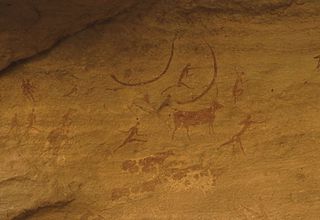
The Epipalaeolithic Near East designates the Epipalaeolithic in the prehistory of the Near East. It is the period after the Upper Palaeolithic and before the Neolithic, between approximately 20,000 and 10,000 years Before Present (BP). The people of the Epipalaeolithic were nomadic hunter-gatherers who generally lived in small, seasonal camps rather than permanent villages. They made sophisticated stone tools using microliths—small, finely-produced blades that were hafted in wooden implements. These are the primary artifacts by which archaeologists recognise and classify Epipalaeolithic sites.

The Neolithic or New Stone Age is an archaeological period, the final division of the Stone Age in Europe, Asia and Africa. It saw the Neolithic Revolution, a wide-ranging set of developments that appear to have arisen independently in several parts of the world. This "Neolithic package" included the introduction of farming, domestication of animals, and change from a hunter-gatherer lifestyle to one of settlement. The term 'Neolithic' was coined by Sir John Lubbock in 1865 as a refinement of the three-age system.

The prehistory of North Africa spans the period of earliest human presence in the region to gradual onset of historicity in the Maghreb during classical antiquity. Early anatomically modern humans are known to have been present at Jebel Irhoud, in what is now Morocco, approximately 300,000 years ago. The Nile Valley region, via ancient Egypt, contributed to the Neolithic, Bronze Age and Iron Age periods of the Old World, along with the ancient Near East.

The Neolithic Revolution, also known as the First Agricultural Revolution, was the wide-scale transition of many human cultures during the Neolithic period in Afro-Eurasia from a lifestyle of hunting and gathering to one of agriculture and settlement, making an increasingly large population possible. These settled communities permitted humans to observe and experiment with plants, learning how they grew and developed. This new knowledge led to the domestication of plants into crops.

Africa has the longest record of human habitation in the world. The first hominins emerged 6-7 million years ago, and among the earliest anatomically modern human skulls found so far were discovered at Omo Kibish, Jebel Irhoud, and Florisbad.

The Capsian culture was a Mesolithic and Neolithic culture centered in the Maghreb that lasted from about 8,000 to 2,700 BC. It was named after the town of Gafsa in Tunisia, which was known as Capsa in Roman times.

The Majiayao culture was a group of neolithic communities who lived primarily in the upper Yellow River region in eastern Gansu, eastern Qinghai and northern Sichuan, China. The culture existed from 3300 to 2000 BC. The Majiayao culture represents the first time that the upper Yellow River region was widely occupied by agricultural communities and it is famous for its painted pottery, which is regarded as a peak of pottery manufacturing at that time.

The Nordic Stone Age refers to the Stone Age of Scandinavia. During the Weichselian glaciation, almost all of Scandinavia was buried beneath a thick permanent ice cover, thus, the Stone Age came rather late to this region. As the climate slowly warmed up by the end of the ice age, nomadic hunters from central Europe sporadically visited the region. However, it was not until around 12,000 BCE that permanent, but nomadic, habitation in the region took root.
The prehistory of the Levant includes the various cultural changes that occurred, as revealed by archaeological evidence, prior to recorded traditions in the area of the Levant. Archaeological evidence suggests that Homo sapiens and other hominid species originated in Africa and that one of the routes taken to colonize Eurasia was through the Sinai Peninsula desert and the Levant, which means that this is one of the most important and most occupied locations in the history of the Earth. Not only have many cultures and traditions of humans lived here, but also many species of the genus Homo. In addition, this region is one of the centers for the development of agriculture.

Prehistoric Thailand may be traced back as far as 1,000,000 years ago from the fossils and stone tools found in northern and western Thailand. At an archaeological site in Lampang, northern Thailand Homo erectus fossils, Lampang Man, dating back 1,000,000 – 500,000 years, have been discovered. Stone tools have been widely found in Kanchanaburi, Ubon Ratchathani, Nakhon Si Thammarat, and Lopburi. Prehistoric cave paintings have also been found in these regions, dating back 10,000 years.
Belbaşı is a cave and a late Paleolithic/Mesolithic site in southern Turkey, located southwest of Antalya.

The Pre-Pottery Neolithic (PPN) represents the early Neolithic in the Levantine and upper Mesopotamian region of the Fertile Crescent, dating to c. 12,000 – c. 8,500 years ago,. It succeeds the Natufian culture of the Epipalaeolithic Near East, as the domestication of plants and animals was in its formative stages, having possibly been induced by the Younger Dryas.
The Kiffian culture is a prehistoric industry, or domain, that existed between approximately 8,000 BC and 6,000 BC in the Sahara Desert, during the African humid period referred to as the Neolithic Subpluvial. Human remains from this culture were found in 2000 AD at a site known as Gobero, located in Niger in the Ténéré Desert. The site is known as the largest and earliest burial place of Stone Age people in the Sahara desert.

Prehistory, also called pre-literary history, is the period of human history between the first known use of stone tools by hominins c. 3.3 million years ago and the beginning of recorded history with the invention of writing systems. The use of symbols, marks, and images appears very early among humans, but the earliest known writing systems appeared c. 5,000 years ago. It took thousands of years for writing systems to be widely adopted, with writing spreading to almost all cultures by the 19th century. The end of prehistory therefore came at very different times in different places, and the term is less often used in discussing societies where prehistory ended relatively recently.

The Savanna Pastoral Neolithic is a collection of ancient societies that appeared in the Rift Valley of East Africa and surrounding areas during a time period known as the Pastoral Neolithic. They were South Cushitic speaking pastoralists who tended to bury their dead in cairns, whilst their toolkit was characterized by stone bowls, pestles, grindstones and earthenware pots.

The Pastoral Neolithic refers to a period in Africa's prehistory, specifically Tanzania and Kenya, marking the beginning of food production, livestock domestication, and pottery use in the region following the Later Stone Age. The exact dates of this time period remain inexact, but early Pastoral Neolithic sites support the beginning of herding by 5000 BP. In contrast to the Neolithic in other parts of the world, which saw the development of farming societies, the first form of African food production was nomadic pastoralism, or ways of life centered on the herding and management of livestock. The shift from hunting to food production relied on livestock that had been domesticated outside of East Africa, especially North Africa. This period marks the emergence of the forms of pastoralism that are still present. The reliance on livestock herding marks the deviation from hunting-gathering but precedes major agricultural development. The exact movement tendencies of Neolithic pastoralists are not completely understood.

The Elmenteitan culture was a prehistoric lithic industry and pottery tradition with a distinct pattern of land use, hunting and pastoralism that appeared and developed on the western plains of Kenya, East Africa during the Pastoral Neolithic c.3300-1200 BP. It was named by archaeologist Louis Leakey after Lake Elmenteita, a soda lake located in the Great Rift Valley, about 120 km (75 mi) northwest of Nairobi.

The Lothagam North Pillar Site, registered as GeJi9, is an archaeological site at Lothagam on the west side of Lake Turkana in Kenya dating to the Pastoral Neolithic and the Holocene. It is a communal cemetery, built between 3000 BCE and 2300 BCE by the region's earliest herders as rainfall in the area decreased and Lake Turkana receded. It is thought to be eastern Africa's largest and earliest monumental cemetery.

The history of East Africa has been divided into its prehistory, the major polities flourishing, the colonial period, and the post-colonial period, in which the current nations were formed. East Africa is the eastern region of Africa, bordered by North Africa, Central Africa, Southern Africa, the Indian Ocean, and the Sahara Desert. Colonial boundaries are reflected in the modern boundaries between contemporary East African states, cutting across ethnic and cultural lines, often dividing single ethnic groups between two or more states.

The prehistory of East Africa spans from the earliest human presence in the region until the emergence of the Iron Age in East Africa. Between 1,600,000 BP and 1,500,000 BP, the Homo ergaster known as Nariokotome Boy resided near Nariokotome River, Kenya. Modern humans, who left behind remains, resided at Omo Kibish in 233,000 BP. Afro-Asiatic speakers and Nilo-Saharan speakers expanded in East Africa, resulting in transformation of food systems of East Africa. Prehistoric West Africans may have diverged into distinct ancestral groups of modern West Africans and Bantu-speaking peoples in Cameroon, and, subsequently, around 5000 BP, the Bantu-speaking peoples migrated into other parts of Sub-Saharan Africa.

















